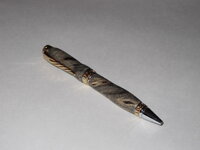I recently purchased some Buckeye Burl (non-stabilized) I'm going through about 3-4 blanks before I can get one to turn down without exploding. Is their any tips or tricks for turning down these beauties? Should I only buy stabilized blanks?
I've only made a handful of pen's, and I progress as I go... but these burl blanks are really frustrating me.
Thanks,
-John
I've only made a handful of pen's, and I progress as I go... but these burl blanks are really frustrating me.
Thanks,
-John

